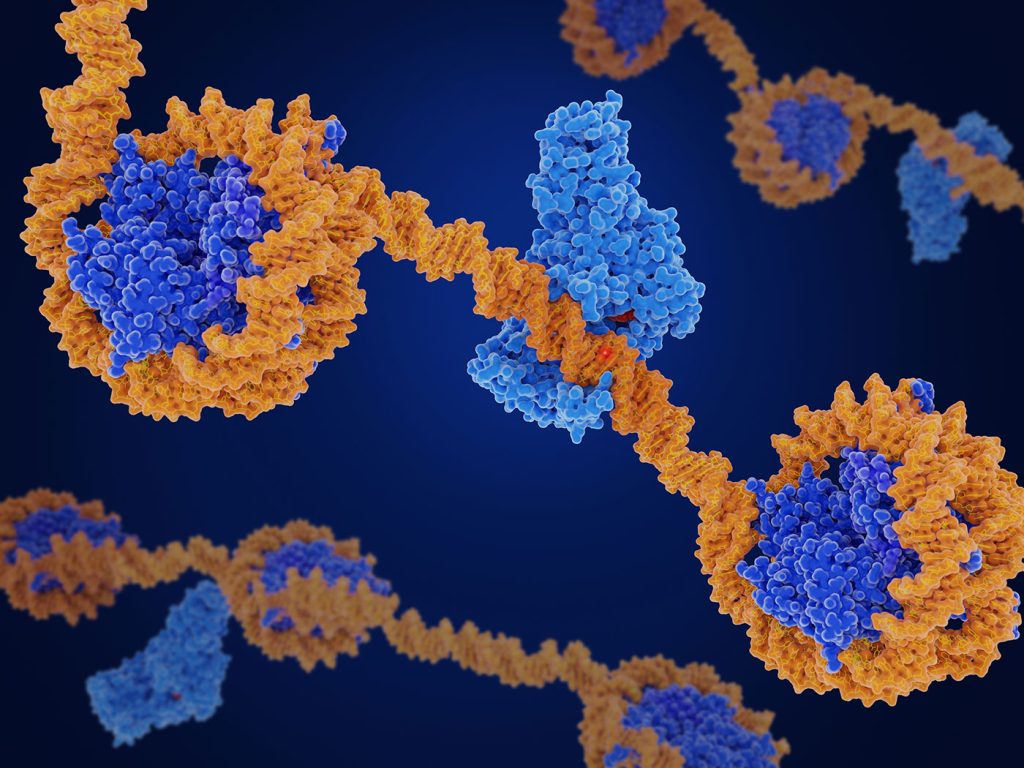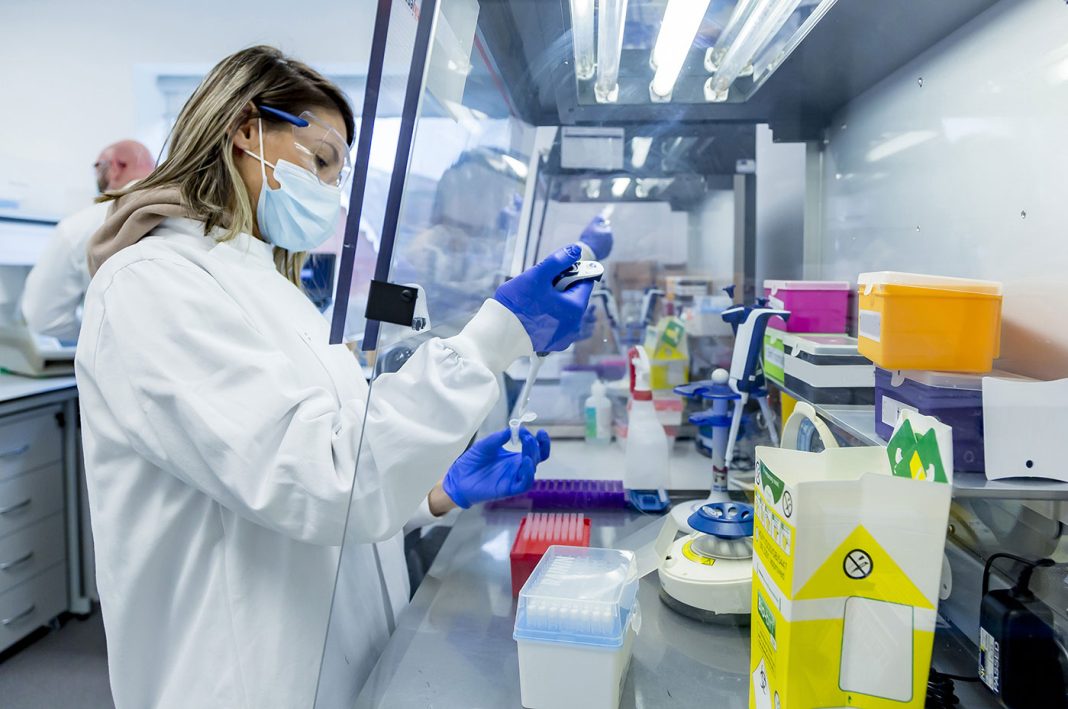Epigenetics, the study of non-DNA-sequence-related heredity, has transformed how we think about gene expression and replication. We now know that epigenetic marks can vary among different tissues of the body as well as over a lifetime. Additionally, we know that epigenetic changes can be reversed. By dissecting the critical roles played by epigenetic mechanisms, we may uncover new approaches to the development of therapeutics against diseases ranging from Alzheimer’s to cancer.

as transcription factors and noncoding RNAs. ]selvanegra/Getty Images]
GEN spoke with several scientists who delivered presentations at “Epigenetics and Epigenomics in Health and Disease,” a Precision Medicine Forum event held in Brussels last November. The scientists described newfound epigenetic mechanisms and pathways, as well as the development of new technologies. For example, several scientists emphasized how next-generation sequencing (NGS) technologies are emerging that make it possible to collect genetic and epigenetic information in a common workflow. Ordinarily, separate analyses are needed.
Further, innovative interdisciplinary approaches combining chemistry and biology are improving the tracking and manipulation of epigenetic chromatin modifications. Researchers also report that extrachromosomal amplifications, especially cancer-causing ones, are more widespread than anticipated. Finally, integrating a multimodal platform with omics data is enabling improved analyses of large cohorts to generate insights on omics signatures.
Recognizing both genetic and epigenetic bases

Cambridge Epigenetix
DNA base sequences incorporate not only genetic bases (G, A, T, C) but also so-called epigenetic bases, which are primarily 5-methylcytosine (5mC) and 5-hydroxymethylcytosine (5hmC). “Epigenomic marks correlate with disease initiation, progression, and subtype,” says Joanna Holbrook, PhD, CSO, Cambridge Epigenetix. “Epigenetic modification of cytosine, in particular, has been shown to be more sensitive in detecting early cancer than genetic biomarkers and can change across the disease course and in response to treatment.
“We know that modified cytosine (modC) marks cooperate with genetic mutations to specify function. Therefore, modC marks combined with genetic information are ideal biomarkers. They have loci-specific effects and interact with each other, so they need to be read at base resolution and integrated at read and workflow levels, which is what we deliver.”
Because the identification of modC is accomplished in addition to the identification of the four genetic letters, most sequencing approaches use the four information states in NGS to identify either genetic or epigenetic information. “With our solution,” Holbrook asserts, “researchers don’t have to make the choice between genetic or epigenetic information: we enable both in the same workflow.”
To achieve this, scientists at Cambridge Epigenetix have expanded the number of information states that can be derived from NGS and use those additional states to digitally measure A, C, G, T, and modC. Holbrook notes, “Additional states of information also give us more opportunities to observe and consequently suppress PCR and sequencing errors, which improves accuracy over standard NGS and other base conversion methods to read modC.”
Cambridge Epigenetix’s technology consists of a single workflow and data pipeline. It starts in the laboratory, where double-stranded DNA fragments are ligated at either end to hairpin structures, such that each hairpin, at its end, joins the complementary strands there. The strands are separated, each of which takes one of the hairpins. And then, for each hairpin-strand complex, the missing strand is synthesized.
During this process, short adapters are ligated, and modified cytosines are protected. Unprotected cytosines are converted via deamination, from cytosine to uracil. Overall, the workflow permits two-base coding, which results in 42 = 16 possible states, thereby enabling simultaneous determination of epigenetic and genetic states.
Each hairpin is opened and amplified via PCR. Indexing adapters are added, and the templates are paired-end sequenced. The two reads represent the same stretch of DNA and need to be locally aligned to minimize errors. At this point, a set of resolution rules is employed. For example, if a five-letter decoding model is applied, the pairs of bases across two reads may be resolved into one of five states: A, C, modC, G, T. Ultimately, cognate residues from both reads may be computationally resolved to produce a single genetic or epigenetic letter.
This technology fundamentally utilizes Watson-Crick base pairing to decode information. Accordingly, as the company’s scientists point out, the technology can be made compatible with any sequencer platform. “The technology can work on very low inputs of DNA and has a simple workflow,” Holbrook adds. “The analysis pipeline is also simple to use and can be hosted wherever you do your bioinformatics.”
Cambridge Epigenetix will be commercially launching its solution this spring. The company sees opportunities for its technology in long-read sequencing and in single-cell analysis.
Epigenetic tools against cancer
“Epigenetic mechanisms primarily rely on the enzymatic modification of both the genetic material itself (RNA and DNA) as well as the structural proteins that hold them in the chromatin structure (histones),” says Yael David, PhD, associate member, Chemical Biology Program, Memorial Sloan Kettering Cancer Center. “Often disruption in the activity of epigenetic enzymes leads to the over- or underexpression of cancer genes, including oncogenes and tumor suppressors. However, there are still major gaps in understanding how stimuli are recorded as chromatin modifications, and in understanding how the modifications induce changes in gene expression.”
Most of the platforms that are used to evaluate epigenetic mechanisms rely on antibodies that recognize a specific modification on chromatin. However, according to David, these platforms have serious limitations such as epitope occlusion effects, differences in binding specificities, and difficulties in acquiring quantitative results. “[These limitations] represent a huge gap in the field,” she cautions. “Although increasing evidence has indicated the potential significance of histone modifications in genomic regulation, we are still in the nascent stages of examining the numerous chromatin states involved in mammalian transcription and cell-fate decisions.”
David’s laboratory recently identified a new family of non-enzymatic modifications. These modifications, which involve sugars that accumulate on histones, appear to influence cell metabolism, potentially giving rise to conditions such as diabetes and cancer. “My laboratory undertakes an interdisciplinary approach, combining chemistry and biology to manipulate, synthesize, and track these modifications,” she remarks. “Using a combination of protein engineering and peptide and small-molecule synthesis, we were able to generate a library of probes, inhibitors, mimics, and semisynthetic proteins to characterize these modifications in normal and cancer cells.”
Her laboratory also made another important discovery. “We identified key regulatory proteins that play a critical role in suppressing the accumulation of these modifications,” she reports. “This information identifies new vulnerabilities in cancer, which we are now targeting with small molecules.”
Gatekeepers of DNA replication and amplification
Genomic instability and copy number alterations are hallmarks of cancer. Further, some replication events produce extrachromosomal DNA that may, in addition to potentially serving important biological functions, play roles in cancer and other diseases.

Fox Chase Cancer Center
“We discovered that a histone demethylase, KDM4A, seemed to be controlling the replication timing of cells,” says Johnathan Whetstine, PhD, professor and director of the Cancer Epigenetics Institute at Fox Chase Cancer Center. Replication timing refers to the temporal order in which genomic regions replicate. “Although we speculated that disrupting this enzyme would lead to global genomic instability, that was not the case,” he continues. “To our surprise, it was regulating only local replication and, in turn, focal amplification.”
Whetstine and his laboratory subsequently identified other critical genomic and epigenomic features that regulate replication timing and DNA copy gains. “We found that regions of the genome, such as pro-survival segments, were being selectively amplified by KDM4A,” he points out. “And we learned that physiological conditions like hypoxia and growth factors could phenocopy the overexpression or misregulation of that enzyme in causing these focal extra chromosomal DNA amplifications.”
Additional studies have created a paradigm shift in understanding extrachromosomal amplifications and their surprisingly widespread existence. “We most recently discovered that certain factors drive both focal amplifications and genetically inherited genomic rearrangements,” Whetstine reports. “These data demonstrate that an epigenetic event can ultimately generate a genetic event.
“This is important because many of these transient amplifications that occur in cancer, especially if an oncogene or extrachromosomal piece, can be controlled by using drugs to modify the process. That means you can turn on the amplification or suppress it. This has major consequences in structural heterogeneity and emphasizes how epigenetics is a gateway to that space. Further, this has implications for cancer treatment. If you can modulate amplification and/or structural variation, you create an opportunity for knowing how that tumor or cell will respond to therapy.”
Whetstine and his laboratory continue to identify players in this process. “[We have determined that these factors have] exquisite specificity in their ability to drive events within the genome,” he declares. “We are realizing that the genome is much more plastic than we anticipated.”
Multimodal data analytics and precision medicine

Citadel
Despite the plethora of diagnostic and exploratory tests that could be performed on cancer and chronically ill patients, not all patients receive comprehensive testing. “This could be due to the lack of availability of tests or the cost of the tests,” says Reena Gollapudy-Vajjhala, PhD, chief scientific officer, Citadel Precision Medicine. “Or it could be due to analyses being limited to research settings.
“While radiological and laboratory tests are performed on almost all patients, genomic and epigenetic tests might not be available or recommended as primary tests. Additionally, assistive artificial intelligence–based technologies that can generate evidence-based integrative insights from a larger pool of patients are currently limited.”
Citadel is addressing these challenges with its Accuitive platform and other technologies. “The Accuitive platform is an integrative omics and multimodal platform that enables analysis of large cohorts to generate insights from cohort and individual omics signatures,” Gollapudy-Vajjhala details. “This allows the prediction of outcomes such as survival, prognosis, response to therapy, and adverse events.
“These multiple modalities provide information for which data might not be available for the individual patient. The platform is currently equipped to consume and analyze clinical data of large cohorts, generate radiomic signatures from MRI, and perform multiomics predictions using genomic and methylomic data. Integration of other omics data is in progress.”
Citadel is also addressing health disparities in resource-rich versus resource-poor settings. Gollapudy-Vajjhala elaborates, “We aim to generate insights globally and apply them locally regardless of health inequities to enable precision decision-making. The accessibility to global insights and hence to better and more affordable medications for the physician and patient communities globally is one of the foremost benefits of the Precision Decision tools being developed by Citadel. This approach also enables the prioritization of investments in healthcare infrastructure as well as to ensure optimal returns on investments.”
Epigenetic pathways and disease
Some scientists define epigenetics more broadly as genomic changes that do not involve DNA sequences but rather changes in chromatin, transcriptional networks, and noncoding RNA. Such epigenetic programs regulate biological processes throughout life. Players, including histones and transcription factors, direct such programs by chemically modifying DNA and proteins. Contrary to stable genetic modifications, epigenetic changes can sometimes be reversed. While the p53 protein plays an important role in enforcing genetic stability, it also helps regulate epigenetic changes in cells. The p53 protein is a tumor suppressor and transcription factor.
Shelley L. Berger, PhD, professor of cell and developmental biology, University of Pennsylvania Perelman School of Medicine, indicates there is significant crosstalk between p53 and epigenetic programs. She and colleagues recently identified novel modifications on p53. They focused on determining how such modifications turn the protein on and off. The scientists found that methylation or demethylation of p53 at a critical lysine residue both activated and repressed p53 function. This regulation was shown to be driven by the p53 coactivator protein, 53BP1.

Many agree that the young, fascinating field of epigenetics has its best days coming. Future discoveries are likely to better decipher how to turn genes “off” or “on” in a controlled manner, paving the way for innovative therapeutics against a host of diseases.





